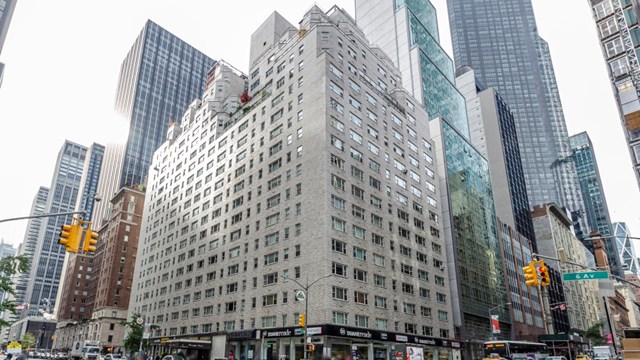Four years ago, the co-op at 430 West 34th Street in Manhattan was in trouble. The 17-story, 168-unit vanilla brick building needed money - and needed it quickly. A couple of major capital projects, including new window installation, grouting and a boiler replacement, were looming, and the board didn't have the money to complete them.
"We needed a way to raise money," recalls Kim Oliver, a board member. "We're a lower middle-income co-op, and there is always something that needs to be repaired."
Trying to spare the shareholders an assessment, Oliver and the other board members explored the possibility of selling advertising space on the side of the building that faced 9th Avenue. But after a year of negotiations, the deal fell through - largely because the local community board was cracking down on banner advertising around the neighborhood.
The board members finally bit the bullet and leveled an assessment on all the shareholders. While that should typically be the end of the story, there is an epilogue. Last year, after the work was completed, the co-op board filed for a J-51 tax abatement, a 47-year-old city tax incentive program created to encourage residential owners to upgrade and maintain their building stock.
Each apartment received about a $300 tax credit through the abatement. With the money saved with the abatement, the co-op is moving ahead on another improvement project, repainting the hallways and putting in new carpeting and light fixtures.
"Most of the co-op owners are middle-income and would be severely hurt if it weren't for the J-51," says Oliver. "We just don't have the money to put in million-dollar repairs."
"This is just a lovely gift from the city, started in the 1950s, to keep the city viable," says Mary Ann Rothman, president of the Council of New York Cooperatives and Condominiums (CNYC), about the tax abatement program.
Started in 1955 as a way to encourage the owners of cold-water flats to install hot water plumbing, the city's J-51 tax abatement program has expanded in the intervening decades to include a host of major capital projects, including but not limited to windows, elevators, electrical wiring, roof repair, plumbing, pointing and sewer line work. At the same time, the program has expanded to benefit property owners who convert nonresidential buildings, and buildings that go co-op and condo.
"Originally, the government allowed three years of J-51 eligibility after a building closed as a co-op or condo," recalls Rothman. "It was clear to [the council] that first of all, it took a co-op a length of time to learn what physical improvements were needed and to accumulate the money to do that. Three years wasn't nearly often long enough, so we got to work lobbying to make our representatives understand that just because people owned a co-op didn't mean they immediately knew how to deal with the program."
In 1988, the council won an important victory: where once a building had only three years after converting to co-op or condo to apply for a J-51, there is now no limit on the number of times co-ops or condos can apply for the abatement program.
"It was quite an achievement," recalls Ed Tristram, a J-51 consultant. The only problem these days, he adds, is that not enough co-ops and condos take advantage of the abatement. Despite the fact that filing for a J-51 can be really complicated, says Tristram, "the potential benefits are at least worth taking a look at."
For potential J-51 filers, Paul Korngold, an attorney specializing in real estate tax law, offers a brief primer:
First, the application to apply for the abatement is available through the city's Department of Housing and Preservation Development (HPD), which has been administering the abatement since it was created. Applications must be filed within two years of a project beginning, or no more than four years after a project has ended.
If the application is approved, HPD gives the building a "certificate of eligibility," which the building must then file with the city's Department of Finance. The Department of Finance then puts the credit into the computer and adjusts the building's taxes accordingly, for the duration of the abatement period.
The abatement period can last for "as little as six years and as many as 20 years," says Korngold, with most co-ops and condos averaging 11 years.
Essentially, the tax abatement serves as a credit used to reduce the building's real estate tax bill, adds Norman Parnass of Ben Rottenstein Associates, a J-51 consulting firm in Brooklyn Heights. The abatements, says Parnass, are based on a calculation of what the city considers a reasonable cost for the work.
The devil is in the details, J-51 experts point out. For what HPD asserts is a "reasonable cost" and what co-ops and condos actually pay for improvements can be quite different.
"For a lot of jobs," says Tristram, "the abatement runs from 40 percent to 70 percent of the actual cost of the work, and then that abatement is just a dollar for dollar reduction in taxes over 10.8 years, subtracted right from the tax bill."
He offers an example: a 104-unit co-op on Schemerhorn Street in Brooklyn Heights hired him to file a J-51 for a boiler replacement, which cost $240,000. The HPD determined that the reasonable cost of replacement was actually $158,000, "and that's the number [the co-op] got 90 percent of," says Tristram. In another example, a 70-unit coop on Remsen Street, also in Brooklyn Heights, redid their windows at a cost of $242,696. Because the building is landmarked, the "reasonable cost" assigned by HPD - $242,600 - was much closer to the actual cost of the project. "Their tax abatement was much larger because of the landmark situation."
While the rules surrounding the eligibility requirements for J-51 abatements can be complicated, there are some basic guidelines. Buildings with as few as three or as many as 6,000 dwelling units are eligible, according to Rottenstein Associates, and vacant buildings undergoing a gut rehabilitation may also qualify.
Then there's all the messy math surrounding how exactly the HPD determines whether co-ops and condos are financially eligible for a J-51. "It's a two-tiered test," explains Robert Grant of Midboro Management in Manhattan. "They look to see if 10 percent of the units have sold in the three years preceding the start of construction, and if they have, then the per-room sale price has to be below a certain number, which changes from time to time, which is linked to the national Fannie Mae maximum mortgage amount for a single-family house.
"If less than 10 percent of the units were sold," Grant continues, "then they look only at the assessed valuation of the unit, which has to be $40,000 or less."
According to Korngold, under the current HPD formula, the per-room sale price cutoff is approximately $105,000 per room.
Observes Meir Mishkoff, a real estate consultant based in Queens: "I find that the J-51, is straightforward, but not straightforward enough that a board would want to take it upon itself to file. The biggest problem I find with co-ops and condos are the violations. An application won't be approved until all Building Department violations are dismissed - and 99 percent of the time, an application is delayed getting completed due to an open Building Department violation."
In the early 1970s, to further encourage the construction of new housing stock, New York State created the 421a exemption, which grants a partial tax exemption to developers of new construction for a period of 10, 15 or 25 years.
To take advantage of the 421a program, developers must apply for the benefit after construction has started and prior to the issuance of a Certificate of Occupancy, says Parnass. Co-ops, condos, and rental buildings are eligible, but only rental buildings that meet certain rent regulations, according to Parnass.
"A 421a applies to new construction; you'll hardly ever see a board, shareholders, or condo owners filing a 421a," observes Mishkoff. "What's important for someone buying into a building that is receiving 421a benefits - if the building isn't brand-new - is to look to see at what point they are in the exemption period. If the exemption is expiring in a year or two, what looks like relatively low taxes may go up very sharply once those benefits expire."
Mishkoff says it's easy for buyers to be seduced by a building's low maintenance or common charges; charges that can shoot up when the 421a exemption ends. "The 421a is in the hands of the developer. It's nothing the shareholders can really get involved with. The J-51 is just the opposite. The boards are very much involved in that," says Mishkoff.
Oliver credits her co-op's management company, Lawrence Properties, with staying ahead of the curve in applying for the J-51 abatement. The co-op's experience, however, according to several J-51 experts, is more the exception rather than the rule.
"For a lot of managing agents, it's a nettlesome job," says one J-51 consultant, who requested anonymity. "There's no glory in it, there's no remuneration, and if anything goes wrong, they are in trouble. My best customers are managing agents who call me up ahead of the project so they have a chance to plan out the filings to get maximum benefits."
In the final analysis, Tristram has parting advice for board members eager to cut through the red tape of the application process. "Do not try and do it yourself. Hire a lawyer. The instructions are not perfectly clear and the pitfalls are very costly."







Leave a Comment